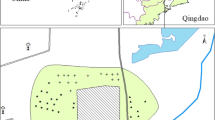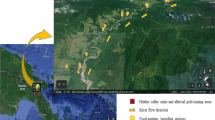Abstract
Municipal waste disposal is an increasing global problem, frequently solved by the use of landfill sites. Following closure, such sites contain a legacy of pollutants and must be managed to provide a safe and useful end life. The soils and vegetation from four historic landfill sites were analysed to determine the extent of pollution by potentially toxic metals (PTMs). Data were subsequently assessed to determine if post closure uses involving grazing were safe for the animals. The heaviest and widest spread soil contamination was due to Ni. Concentrations at all sites exceeded the 95th percentile value for rural soils, in one case by a factor of 30. Cu and Pb contamination was identified at some sites, but no evidence of Al or Zn contamination was found. Oral bioaccessibility testing showed that the availability of Ni in soil was exceedingly low, whilst that of Cu and Pb was high. Concentrations in plant shoots differed significantly amongst the sites, but interspecific differences in shoot concentration were only significant in the case of Cu. The results indicated that exposure levels to grazers would be at or below tolerable levels, indicating that it is generally safe to graze historic landfill. However, animals could be exposed to higher levels of PTMs than would be expected from rural locations, and grazing under conditions where soil consumption may be high could result in levels of exposure to Al, Ni and Pb exceeding tolerable levels.


Similar content being viewed by others
References
Abrahams, P. W., & Thornton, I. (1994). The contamination of agricultural land in the metalliferous province of Southwest England: Implications to livestock. Agriculture, Ecosystem and Environment, 48, 125–137.
Barry, D. L., Summersgill, I. M., Gregory, R. G., & Hellawell, E. E. (2001). Remedial engineering for closed landfill sites. London: CIRIA.
Casteel, S. W. (2001). Metal toxicosis in horses. Veterinary Clinics of North America. Equine Practice, 17(3), 517–527.
COPA. (1974). Control of pollution act (c. 40). London: HMSO.
Dao, L., Morrison, L., et al. (2013). Spatial distribution of potentially bioavailable metals in surface soils of a contaminated sports ground in Galway, Ireland. Environmental Geochemistry and Health, 35(2), 227–238.
Das, K. K., Das, S. N., & Dhundasi, S. A. (2008). Nickel, its adverse health effects & oxidative stress. Indian Journal of Medical Research, 128, 412–425.
DEFRA (2011). Waste data overview. Department for the Environment, Food and Rural Affairs. www.defra.gov.uk/statistics/files/20110617-waste-data-overview.pdf. Accessed 27 May 2012.
Dewes, H. F. (1996). The rate of soil ingestion by dairy cows and effect on available copper, calcium, sodium and magnesium. New Zealand Veterinary Journal, 44, 199–200.
Dulphy, J. P., Jouany, J. P., Martin-Rosset, W., & Thériez, M. (1994). Aptitudes comparées de différentes espéces d'herbivores domestique à ingérer et digérer des fourrages distributes à l’auge. Annales de Zootechnie, 4(3), 11–32.
European Commission (2003). Commission Directive 2003/100/EC of 31 October 2003 amending Annex I of Directive 2002/32/EC of the European Parliament and of the Council on undesirable substances in animal feed. Official Journal of the European Communities L, 285/33.
European Council (1999). Council Directive 1999/31/E of 26 April 1999 on the landfill of wastes. Official Journal of the European Communities L, 182/42.
Fogarty, U., Perl, D., Good, P., Ensley, S., Searight, A., & Noonan, J. (1998). A cluster of Equine granulomatous enteritis cases: the link with aluminium. Veterinary & Human Toxicology, 40(5), 297–305.
Green, N., Johnson, D., & Wilkins, B. T. (1996). Factors affecting the transfer of radionuclides to sheep grazing on pasture reclaimed from the sea. Journal of Environmental Radioactivity, 30, 173–183.
Green, I. D., Jeffries, C., Diaz, A., & Tibbett, M. (2006). Contrasting behaviour of cadmium and zinc in a soil-plant-arthropod system. Chemosphere, 64, 1115–1121.
Healy, W. B. (1968). Ingestion of soil by dairy cows. New Zealand Journal of Agricultural Research, 11(2), 487–499.
Healy, W. B. (1974). Ingested soil as a source of elements to grazing animals. In W. G. Hoekstra (Ed.), International symposium on trace element metabolism in animals (pp. 448–449). Madison: University Park Press, University of Wisconsin.
Hernández, A.J., Bartolomé, C., Paérez-Leblic, M.I., Rodríguez, J., Álvarez, J., Pastor, J. (2012). Ecotoxicological diagnosis of a sealed municipal landfill. Journal of Environmental Management, 95(Supplement), S50–S54.
ICRCL - Interdepartmental Committee on the Redevelopment of Contaminated Land (1990). Notes on the development and after use of landfill sites, 8th ed. South Ruislip: Department of the Environment.
Kabata-Pendias, A., & Pendias, H. (2001). Trace elements in soils and plants (3rd ed.). Boca Raton: CRC.
Khajuria, A., Yamamoto, Y., & Morioka, T. (2010). Estimation of municipal solid waste generation and landfill area in Asian developing countries. Journal of Environmental Biology, 31(5), 649–654.
LRM – Land and Resource Management (2007). Interim guidance on landfill closure: capping and restoration. London: Department of the Environment.
Martin, I., Morgan, H., Jones, C., Waterfall, E., Jeffries, J. (2009). Soil guideline values for nickel in soil. Science Report SC050021/Nickel SGV. Bristol: Environmental Agency.
McDonald, P., Edwards, R. A., & Greenhalgh, J. F. D. (1988). Animal nutrition. Harlow: Longman Scientific & Technical.
McGreevy, P. D., Hawson, L. A., Habermann, T. C., & Cattle, S. R. (2001). Geophagia in horses: a short note on 13 cases. Applied Animal Behaviour Science, 71, 199–125.
Merck (2005). The Merck Veterinary manual a handbook of diagnosis, therapy, and disease prevention and control for the veterinarian, 9th ed. Rahway Merck & Co. Inc.
Merrington, G., Winder, L., & Green, I. (1997). The uptake of cadmium and zinc by the bird-cherry oat aphid Rhopalosiphum padi (Homoptera: Aphididae) feeding on wheat grown on sewage sludge amended agricultural soil. Environmental Pollution, 96, 111–114.
Misgav, A., Perl, N., & Avnimelech, Y. (2001). Selecting a compatible open space use of a closed landfill site. Landscape and Urban Planning, 55, 95–111.
Murphy, A. P., Coudert, M., & Barker, J. (2000). Plants as biomarkers for heavy metal contaminants on landfill sites using sequential extraction and inductively coupled plasma atomic emission spectroscopy (ICP-AES). Journal of Environmental Monitoring, 2, 621–627.
Njue, C. (2010). Metal migration from coastal and estuarine landfills: an integrated geological study from southern England. PhD thesis. University of Brighton.
NRC - National Research Council of the National Academies. (2005). Mineral tolerance of animals (2nd ed.). Washington: National Academies.
Oomen, A. G., Hack, A., Minekus, M., Zeijdner, E., Cornelis, C., Schoeters, G., Verstraete, W., Van de Wiele, T., Wragg, J., Rompelberg, C. J., Sips, A. J., & Van Wijnen, J. H. (2002). Comparison of five in vitro digestion models to study the bioaccessibility of soil contaminants. Environmental Science and Technology, 36, 3326–3334.
Pastor, J., & Hernandez, A. J. (2012). Heavy metals, salts and organic residues in old solid urban waste landfills and surface waters in their discharge areas: determinants for restoring their impact. Journal of Environmental Management, 95, Supplement, S42–S49.
Rahman, M. L., Tarrant, S., McCollin, D., & Ollerton, J. (2011). The conservation value of restored landfill sites in the East Midlands, UK for supporting bird communities. Biodiversity and Conservation, 20, 1879–1893.
Sauerbeck, D. R. (1991). Plant, element and soil properties governing uptake and availability of heavy metals derived from sewage sludge. Water Air Soil Pollution, 57–58, 227–237.
SCAN. (2003). Opinion of the scientific committee on animal nutrition on undesirable substances in feed. Brussels: European Commission, Health & Consumer Protection Directorate-General.
SHS. (2007). UK soil and herbage pollutant survey report No. 1. Bristol: Environmental Agency.
Simmons, E. (1999). Restoration of landfill sites for ecological diversity. Waste Management Research, 17, 511–519.
Simon, F. G., & Mǚller, W. W. (2004). Standard and alternative landfill capping design in Germany. Environmental Science & Policy, 7, 277–290.
Slack, R. J., Gronow, J. R., & Voulvoulis, N. (2009). The management of household hazardous waste in the United Kingdom. Journal of Environmental Management, 90, 36–42.
Smith, M. T. E., Cade-Menun, B. J., & Tibbett, M. (2006). Soil phosphorus dynamics and phytoavailability from sewage sludge at different stages in a treatment stream. Biology and Fertility of Soils, 42(3), 186–197.
Suflita, J. M., Gerba, C. P., Ham, R. K., Palmisano, A. C., Rathje, W. L., & Robinson, J. A. (1992). The world's largest landfill. Environmental Science & Technology, 26(8), 1486–1495.
Thornton, I. (2002). Geochemistry and the mineral nutrition of agricultural livestock and wildlife. Applied Geochemistry, 17, 1017–1028.
Thornton, I., & Abrahams, P. (1983). Soil ingestion—a major pathway of heavy metals into livestock grazing contaminated land. Science of the Total Environment, 28, 287–294.
Townsend, D., Stace, H., Radley, D. (2004). State of nature: lowlands—future landscapes for wildlife. Peterborough: English Nature.
U.S. Phamacopeia (1990). The United Stated Pharmacopeia XXII. Rockville: United States Pharmacopeia Convention Inc.
Watson, D., & Hack, V. (2000). Wildlife management and habitat creation on landfill sites—a manual of best practice. Richmond: Ecoscope Applied Ecologists.
Wilkinson, J. (2012). Flooding and eroding coastal landfills: Institutions working together for solutions. In A. Schofield (Ed.), Innovative coastal zone management: sustainable engineering for a dynamic coast (pp. 201–210). London: ICE Publishing.
Xiang, X. Y., Chen, L., Kueppers, S., Zhang, M. H., Tang, H., Li, Z. Y., & Li, Y. Q. (2011). Turn brownfield into green space-eco-regeneration of closed landfill. Advanced Materials Research, 414, 63–67.
Author information
Authors and Affiliations
Corresponding author
Rights and permissions
About this article
Cite this article
Green, I.D., Boughey, K. & Diaz, A. Potentially Toxic Metals in Historic Landfill Sites: Implications for Grazing Animals. Water Air Soil Pollut 225, 2110 (2014). https://doi.org/10.1007/s11270-014-2110-y
Received:
Accepted:
Published:
DOI: https://doi.org/10.1007/s11270-014-2110-y




